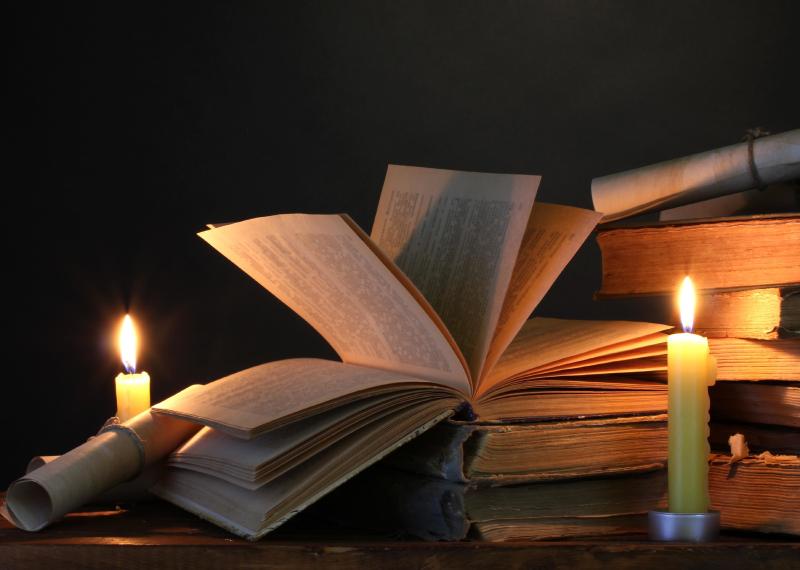Stack of books lit by candles Tribune Content Agency
* Spoiler Alert: Do not read if you want to avoid spoilers/how the film ends.
I recently stumbled upon “The Witch,” a supernatural horror film that was originally released in 2015. The film follows a farmer’s family in seventeenth-century New England after their banishment from a Puritan settlement. They are forced to relocate and end up choosing a spot to start fresh near the woods and without neighbors. What they encounter is something no one could have predicted.
I watched this film twice in a 24-hour period of time. During the first watch, I strongly disliked the overarching plot as well as the characters.
However, as I watched a second time, I developed a greater understanding and appreciation for this movie as an art form in itself.
Before going into specifics, it is important to note that this movie will be easier to understand with subtitles on. To add to the accuracy of the time period and language, the characters speak with thick accents that were hard to understand on my first watch without subtitles.
After reading the dialogue, the movie became more enjoyable and interesting.
The language and accents are not the only key to maintaining the accuracy in the film. Cinematographer Jarin Blaschke contributed heavily to the lighting in the film, which was either natural or by fire throughout.
The darkness combined with chilling visuals of the outdoor scenery made for a convincing setting that is certainly not on my travel bucket list. I found that this also allowed “The Witch” to excel compared to some other horror films— everything felt raw and realistic.
The crew did wonders with capturing horrific imagery as well. Throughout the film, viewers are exposed to naked bodies, bloody scenes, dead animals, and cult-like rituals. I consider these types of shots to make or break horror films, as many can come off as cheesy or fake.
Yet this film appears to use no special effects, which goes back to the accurate depiction of the seventeenth century.
This follows along with the history behind what possibly inspired “The Witch.” Events like the Salem Witch Trials happened not long after the time period this movie took place. In a setting with no technology and few people, the events that happen are chilling to witness as the family slowly falls deeper into a mess their prayers will not fix.
The part of the film that angered me the most was Katherine’s character. Katherine plays the mother of the five children. Thomasin is the oldest daughter, who ends up targeted since younger brother Samuel’s disappearance in the beginning.
Thomasin later ends up being the one found after brother Caleb disappears in the woods, only to appear later without clothing and delirious. He awakens one final time, speaking nonsense while coughing up blood and an apple, resulting in his death.
His death is blamed on Katherine, who is claimed by the twins, her only alive siblings left, to be a witch. They are not far from the truth— the witch is shown in the film to be responsible for the deaths and disappearances thus far. Thomasin, however, has no part in this yet.
With the traumatic events taking place, it was upsetting to see Thomasin take the blame for every problem. What happens in the end, while fitting, is even more traumatizing.
I do feel like the end to this film is beautifully unusual. As a supernatural horror, we do not see much of the witch, who causes the family’s troubles. Rather, we see the family fall into a state of madness, turning on each other and leading to their ultimate demise.
Thomasin’s character ends up being locked in a shed-like structure overnight with the twins and Black Phillip, the goat who ends up embodying some sort of devil that can speak.
After waking up, she watches her father killed by Black Phillip. Shortly after, Katherine stumbles out of the house, yelling at Thomasin for the latest mess, to no one’s surprise.
She engages in a brutal fight with Thomasin, attempting to strangle her to death. In the end, Thomasin has to kill her mother to survive.
This part was difficult to watch, as Thomasin’s character embraces a limp body after the deed is done. There is love and regret, but it is towards a person who treated her heartlessly.
From the beginning, Thomasin’s character stood out and was picked on more than the rest. To see her be the only one walking away alive was decent. I found it interesting to watch her decline into the madness of the whole situation.
The ending leaves the door open for interpretation, with a floating Thomasin who appears to have sold her soul to the devil. With the circumstances her character was under, I feel like this was a sensible end, but we are left to wonder what happens next. The twins’ fate remains unclear.
I would rate “The Witch” a 7/10, mostly due to the incredible accuracy used to depict the terrors that once flooded real-world towns. The film took that fear and gave it a horror-movie twist that deserves to be a classic.

